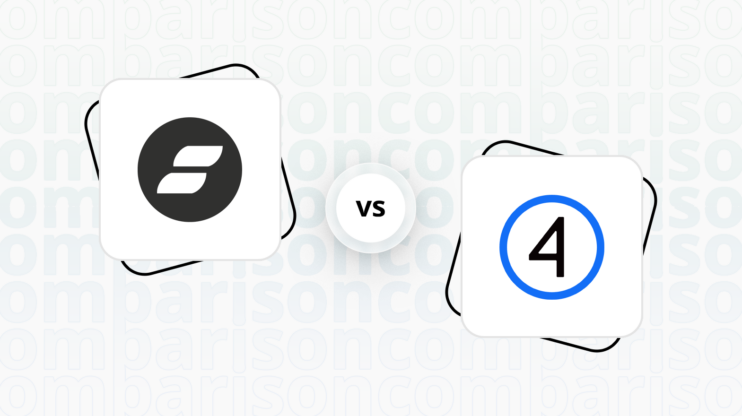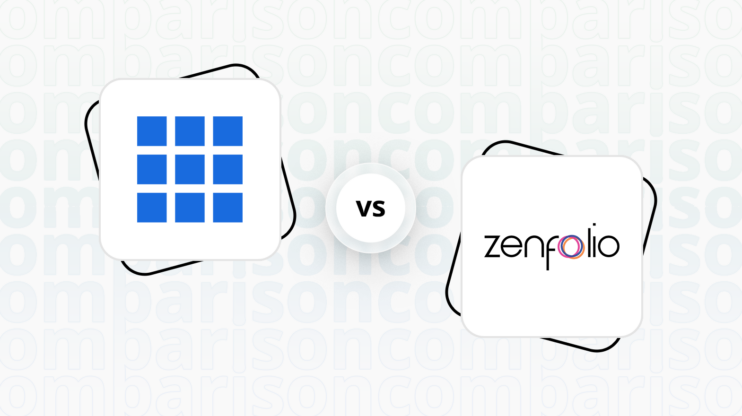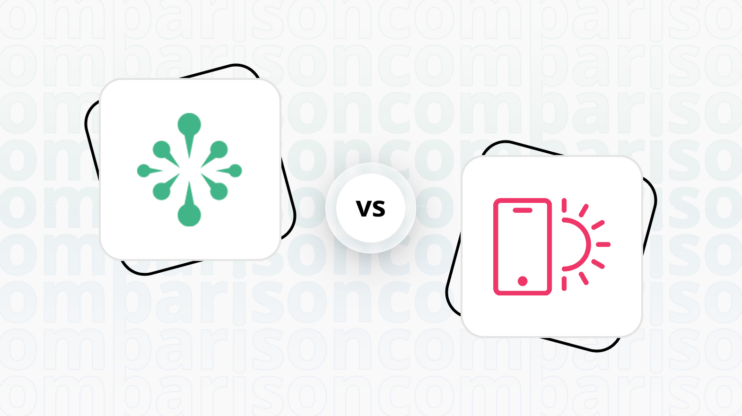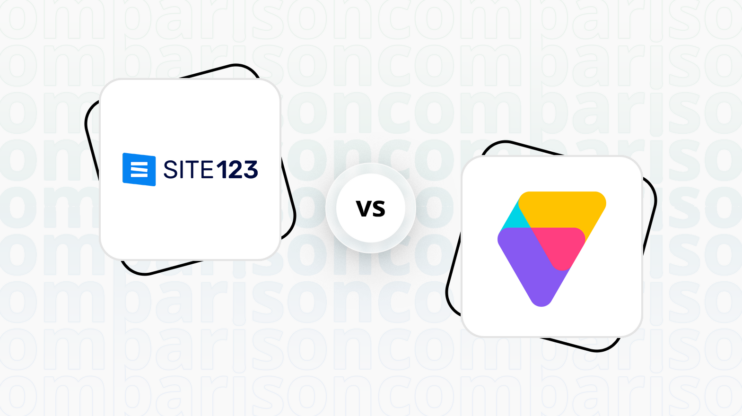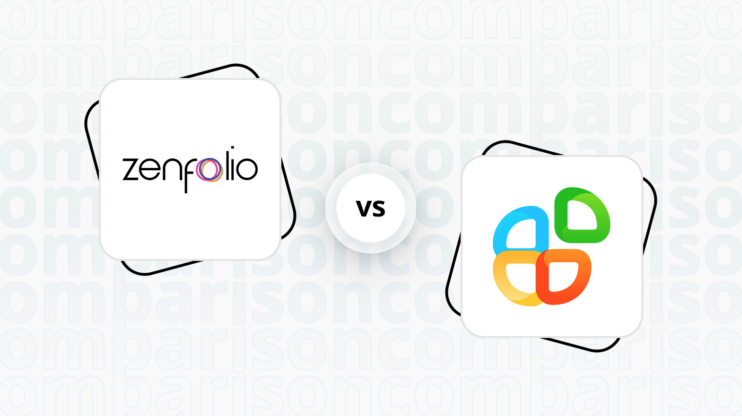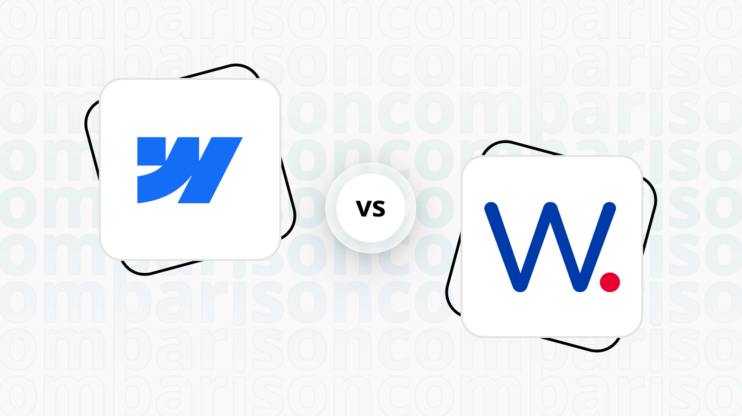SmugMug vs Showit: Final verdict
SmugMug and Showit both cater to creative professionals, but they serve slightly different needs.
-
SmugMug (Overall Grade: 6.3/10)
is tailored for photographers and visual artists who want to showcase and sell their work online. It offers robust photo protection features, customizable templates, and ecommerce capabilities, making it a solid choice for those focused on photography. However, its versatility for other types of websites is limited compared to Showit. -
Showit (Overall Grade: 6.4/10)
excels in design flexibility and customization, making it ideal for creative professionals who want to create visually stunning websites without coding. Its dual canvas interface and integration with WordPress for blogging provide a high degree of control over the website’s appearance on different devices. While it offers basic ecommerce functions, it is not as comprehensive as SmugMug’s ecommerce features.

|

|
|
|---|---|---|
| Design functionalities & templates |
7.1 |
8.5 |
| Ease of use |
7.8 |
8.6 |
| Ecommerce |
7.3 |
4.8 |
| Website editors |
7.3 |
8.0 |
| Product testing options |
7.4 |
8.3 |
| Price |
7.8 |
7.9 |
| Hosting quality |
5.0 |
7.3 |
| Website speed optimization |
5.5 |
5.4 |
| Plugins/extensions and integrations |
6.2 |
5.8 |
| Marketing features |
3.8 |
7.2 |
| Customer support |
7.9 |
6.4 |
| Website security |
6.0 |
8.3 |
| User management |
7.2 |
6.7 |
Which one is the best for ecommerce: SmugMug or Showit?
 7.3
7.3
 4.8
4.8
Verdict
: SmugMug is better suited for photographers and creatives looking to sell their work online, while Showit offers basic ecommerce capabilities through third-party integrations.
-
SmugMug
: SmugMug excels in providing ecommerce features tailored for photographers, including digital downloads, product pricing, tax handling, and multiple currency support. It is ideal for creatives who want to showcase and sell their work online. However, when comparing SmugMug vs Showit, SmugMug’s ecommerce capabilities are more comprehensive and built-in, making it a stronger choice for dedicated ecommerce needs. -
Showit
: Showit offers basic ecommerce functionalities primarily through integrations with platforms like Shopify and WooCommerce. It is more focused on providing design flexibility and creative freedom, making it suitable for visually oriented websites. However, it lacks the comprehensive ecommerce features found in SmugMug, making it less ideal for extensive ecommerce operations.
Which one is the best for informational and business websites?
 7.5
7.5
 8.7
8.7
Verdict
: Showit is the superior choice for creating informational and business websites, thanks to its high degree of customization and user-friendly interface. SmugMug, while excellent for photographers, is less versatile for general informational sites.
-
SmugMug
: SmugMug is tailored for photographers and creatives, offering customizable templates optimized for high-quality image display. It includes robust photo protection features and e-commerce capabilities, making it ideal for showcasing and selling visual work. However, its focus on photography limits its versatility for broader informational website needs.
Score: 7.5
-
Showit
: Showit excels in creating custom, mobile-responsive websites with its drag-and-drop interface. It offers extensive design flexibility and integrates seamlessly with WordPress for blogging. This makes it a top choice for creative professionals who need a highly customizable and visually appealing website.
Score: 8.7
SmugMug vs Showit: Detailed comparison
Design functionalities & templates
Design FunctionalitiesRepresents how well each platform allows for creative design and customization of websites.Score Components:
- Template Variety (30%): Range and quality of design templates.
- Customization (30%): Flexibility and options for design alterations.
- User Interface (20%): Ease and intuitiveness of the design process.
- Responsiveness (10%): Adaptability to different devices and screen sizes.
- Innovation (10%): Unique design features and tools.
 7.1
7.1
 8.5
8.5
🏆
Winner: Showit.
Showit’s design functionalities and templates score is higher than SmugMug’s, making it the preferred choice for users who prioritize design flexibility and customization.
SmugMug offers a variety of templates and designs, catering to the diverse needs of photographers and visual artists. Users can choose from an extensive collection of customizable templates, ensuring their website or portfolio reflects their unique style and brand.
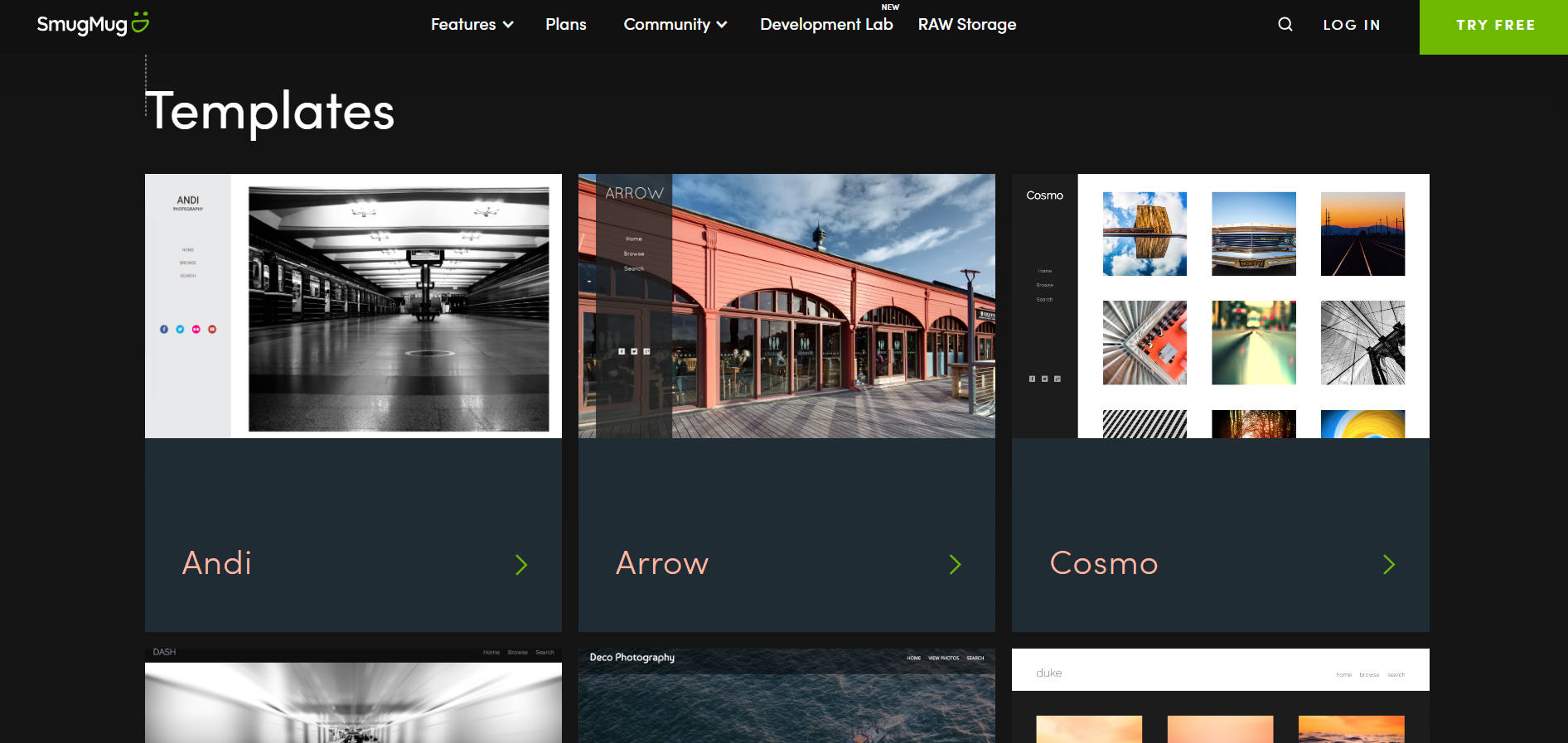
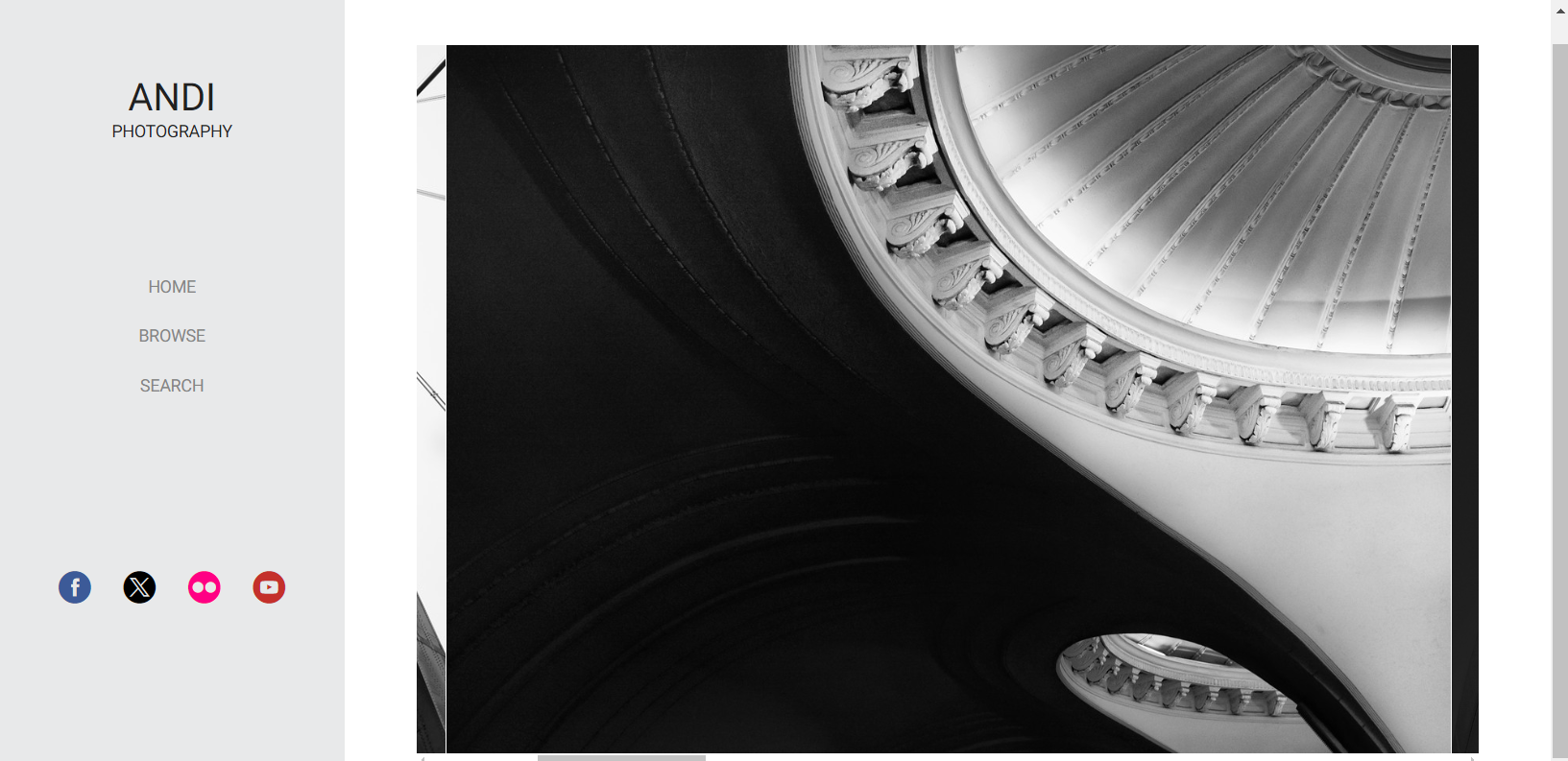
On the other hand, Showit offers a wide variety of templates and designs, catering to diverse aesthetic preferences and business needs. Users can choose from an extensive collection that ranges from minimalist and sleek to bold and artistic, ensuring there’s something for every brand identity.

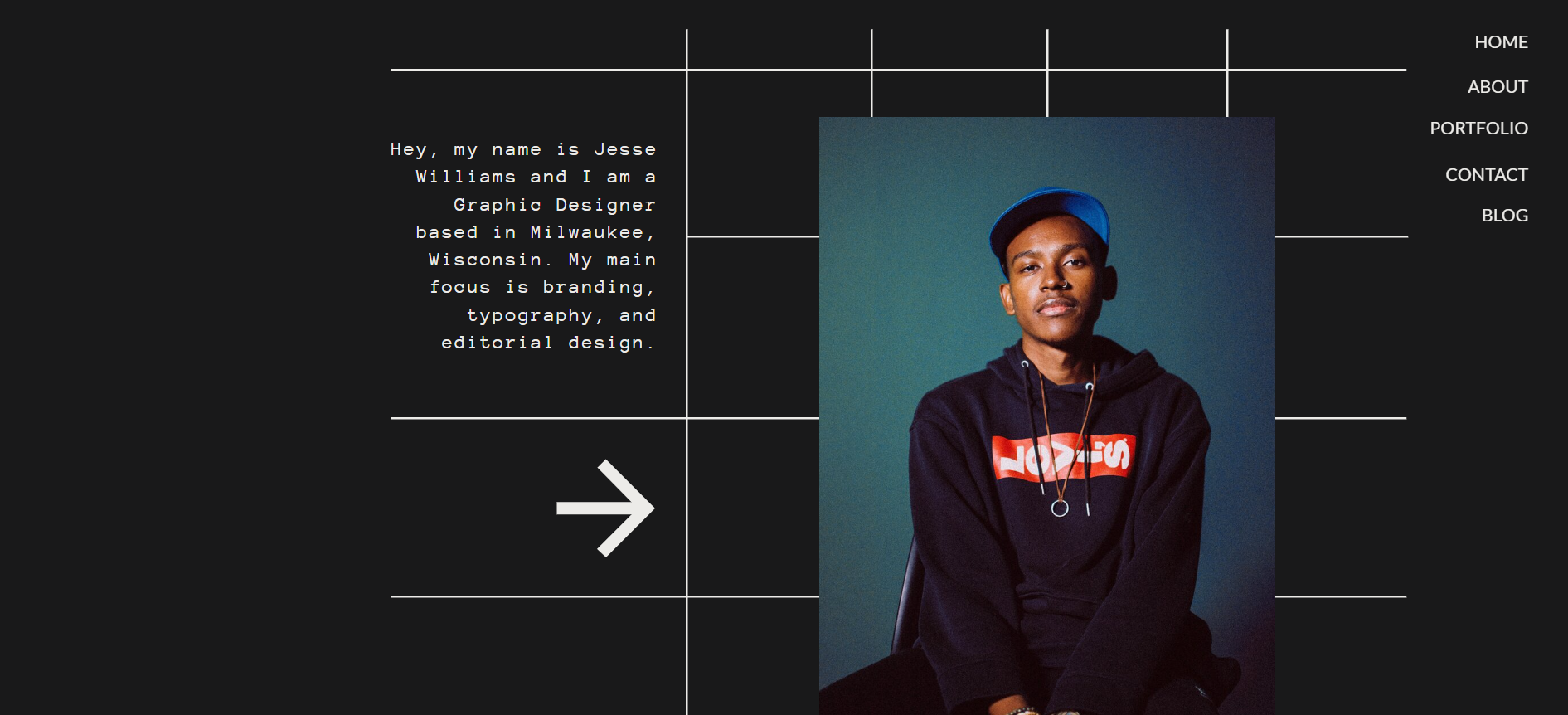
Get a head start on website creation with AI
Create a custom website tailored to your business needs 10X faster with 10Web AI Website Builder!
Ease of use
Ease of useReflects the platform’s overall user-friendliness.Score
Components:
- Learning curve (40%): Quickness and ease of getting started.
- Interface design (30%): Simplicity and intuitiveness of layout.
- User guidance (20%): Quality of tutorials and support.
- Flexibility (10%): Adaptability to various user skills.
 7.8
7.8
 8.6
8.6
🏆 Winner: Showit
. With a score of 8.6, Showit offers a user-friendly drag-and-drop interface that allows users to create custom websites without needing any coding knowledge. SmugMug, scoring 7.8, also provides a user-friendly interface but is more focused on photography and visual content, making it less versatile for other types of websites.
Learning Resources
🏆 Winner: Showit
. Showit offers a comprehensive training course, a learning hub with videos, help documents, a dedicated support team, and a private Facebook group for community advice and peer support. SmugMug also provides learning materials and features, including beginner’s guides and tutorials on YouTube, but does not offer as extensive resources as Showit.
For ecommerce
EcommerceMeasures the platform’s effectiveness in supporting online business activities.Score Components:
- Ecommerce themes and templates (20%): Variety and design of templates.
- Product management (25%): Ease of managing and organizing products.
- Payment options (25%): Variety and convenience of payment methods.
- Ecommerce features (20%): Features for managing an ecommerce store.
- Integration (10%): Compatibility with external e-commerce tools and services.
 7.3
7.3
 4.8
4.8
When it comes to ecommerce, SmugMug and Showit cater to different needs. SmugMug is designed for photographers and creatives who want to sell their work online, offering a range of ecommerce features such as digital downloads, product pricing, tax handling, discounts and coupons, and support for multiple currencies. On the other hand, Showit is primarily a website builder focused on design, offering great flexibility and creative freedom, making it ideal for visually oriented websites rather than extensive e-commerce platforms. It includes basic ecommerce functions but lacks the comprehensive ecommerce features found in platforms like Shopify or WooCommerce, however Showit allows integration of both the mentioned platforms for enhancing ecommerce capabilities.

|

|
|
|---|---|---|
|
Ecommerce themes and templates |
8.0 |
2.0 |
|
Product page customization |
6.5 |
2.5 |
|
Payment processing and commissions |
6.0 |
4.0 |
|
POS capabilities |
0.0 |
1.0 |
|
Payment gateways |
5.0 |
4.5 |
|
Product numbers |
9.0 |
3.0 |
|
Additional ecommerce features |
6.5 |
3.5 |
SmugMug ecommerce features:
- Digital Downloads
- Product Pricing
- Tax handling
- Discounts and Coupons
- Multiple Currencies support
Showit ecommerce features:
- Shopify and WooCommerce integration
Ecommerce themes & templates
Almost all of the templates of Smugmug are designed with ecommerce in mind, providing built-in shopping cart functionality. Showit, on the other hand, does not have any ecommerce specific templates.
Product page customization
SmugMug prioritizes photography, offering a platform tailored for photographers to showcase and sell their work, despite having more limited product page customization compared to dedicated e-commerce platforms. It still provides enough functionality to detail digital and printed photography products effectively, enabling users to sell online with ease. This balance between showcasing art and facilitating sales makes SmugMug a suitable choice for photographers looking to professionalize their online presence and monetize their art efficiently. Showit has very basic ecommerce capabilities, primarily through its integration with WooCommerce and Shopify.
Payment processing
When it comes to payment processing, SmugMug has a unique approach. Payment processing for your sales is managed through your account settings, where you must complete a Tax & Payment form to set up your payment preferences. You can choose your profit payment schedule, with automatic monthly payments for balances over $500, or request payments for lower amounts. Your earnings are calculated as 85% of the markup on print prices or download sales, with SmugMug retaining 15% to cover various costs. Payments are made via ACH direct deposit for U.S. users or PayPal for international users, processed on the first business day after the 7th of each month for profits accumulated through the end of the previous month. Showit supports e-commerce by allowing integration with third-party platforms like Shopify Lite, ThriveCart, WooCommerce, and Podia, rather than offering direct payment processing or POS capabilities. Users can add e-commerce functionalities to their Showit sites using embed codes for “Buy Buttons” or similar features from these platforms. The choice of platform depends on the user’s specific needs, including product type, store size, and budget, as each platform has its own pricing and transaction fee structures. Additionally the platform supports integration of PayPal pay button, allowing users to pay directly through their PayPal account.
Website Editors
Website EditorsEvaluates the platforms’ website building and editing capabilities.Score Components:
- Customization tools (40%): Range and power of editing features.
- Editor usability (30%): User experience within the editor.
- Design flexibility (20%): Freedom in layout and design changes.
- Update and maintenance ease (10%): Simplicity of updating and maintaining the site.
 7.3
7.3
 8.0
8.0
🏆
Winner: Showit
. Showit, with a score of 8.0, is designed for creating custom, responsive websites with a focus on ease of use, especially for photographers and creative professionals. It allows users to design their website visually with a drag-and-drop interface, eliminating the need for coding knowledge. Users can create highly customized pages by adjusting layouts, fonts, and colors, and can also incorporate multimedia elements like videos and images directly into their designs. Additionally, Showit offers deep integration with WordPress for blogging, enabling users to manage and publish blog posts within the same platform, providing a seamless experience from website design to content management.
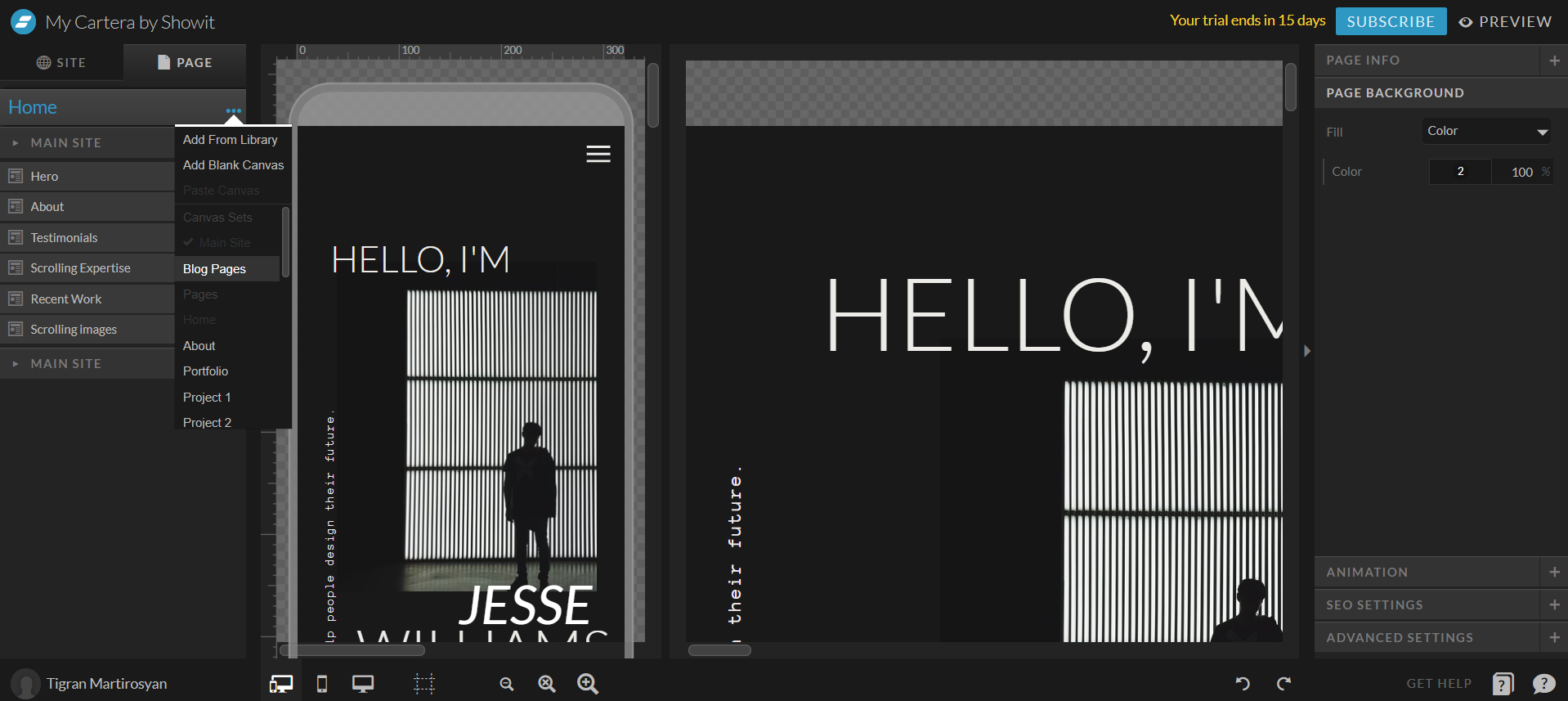
SmugMug’s website builder editor, scoring 7.3, offers a user-friendly interface that allows for the creation of visually appealing, professional-grade photography websites without the need for coding knowledge. Users can customize their site by choosing from a variety of templates, adjusting layouts, and incorporating their own branding elements like logos and colors. The editor also supports easy uploading, organizing, and showcasing of high-quality images, with robust privacy and security settings to protect content. Additionally, SmugMug provides tools for selling prints and digital downloads directly from the website, making it a comprehensive platform for photographers looking to display and monetize their work online.
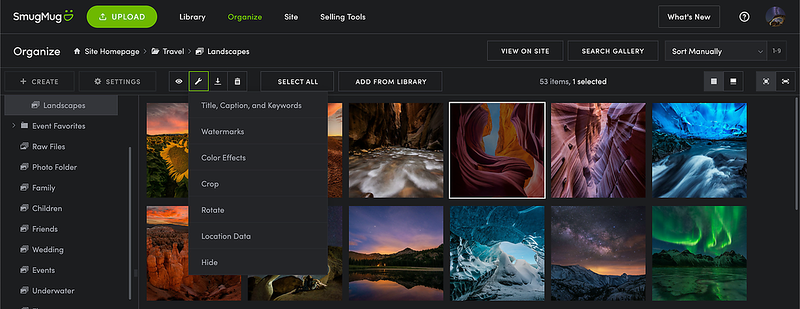
Mobile editor/app
 7.5
7.5
 0
0
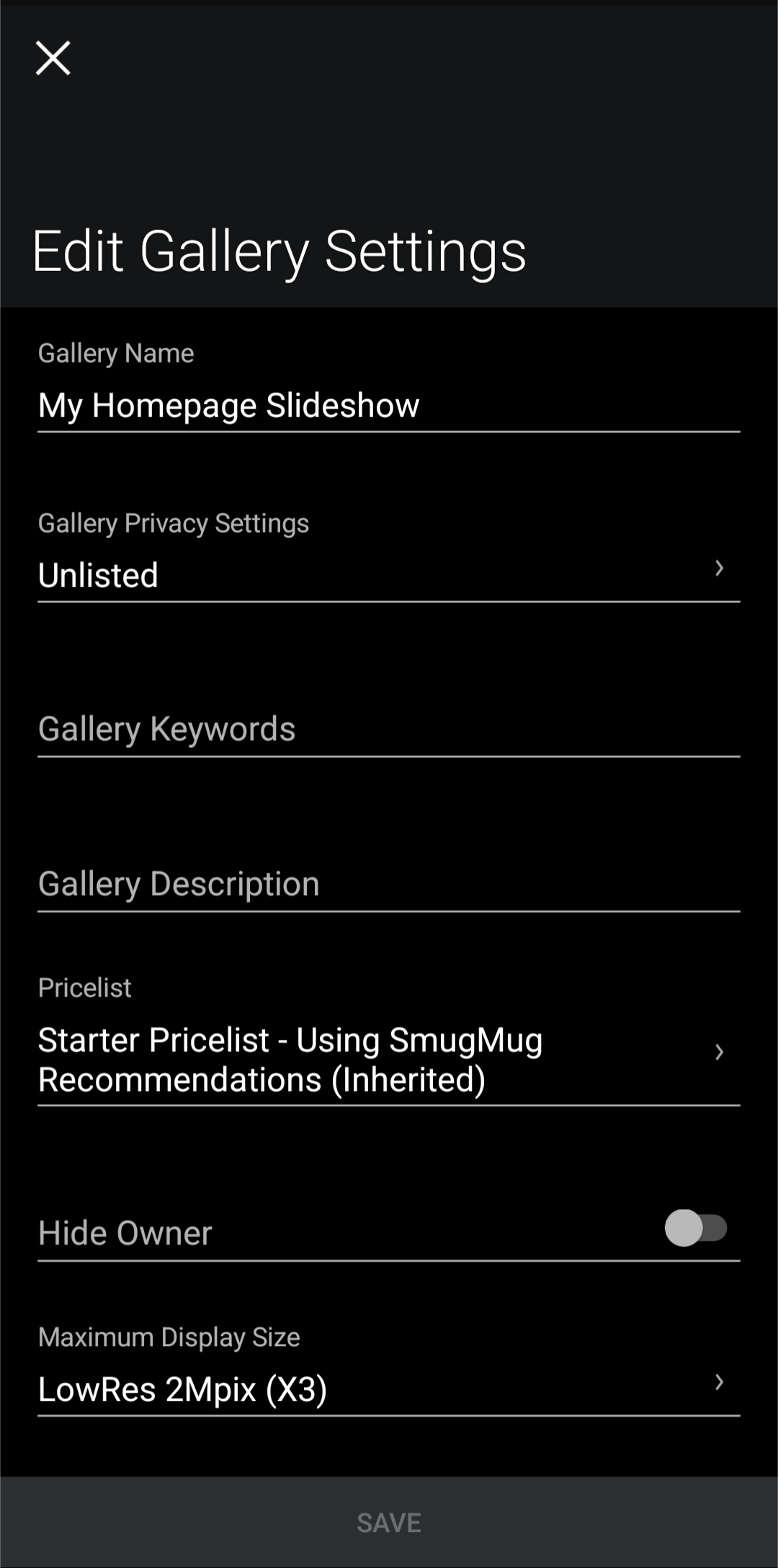
🏆
Winner: SmugMug
. Both SmugMug and Showit are designed for creative professionals, with a focus on photographers. However, when it comes to mobile editing capabilities, SmugMug has a slight advantage. SmugMug offers a mobile editing app, but its functionality is limited to adding new photos and editing descriptions.
Showit, on the other hand, does not have a dedicated mobile editor app, and it’s not possible to edit a Showit website using a mobile browser version. Therefore, while neither platform offers comprehensive mobile editing capabilities, SmugMug provides a basic level of functionality that Showit does not.
In summary, SmugMug receives a higher rating due to its basic mobile editing capabilities, while Showit does not offer any mobile editing functionality.
Product testing options
Product Testing OptionsAssesses the options for trying out platform features before commitment.Score Components:
- Trial quality (40%): Extent and usefulness of the trial or free version.
- Feature accessibility (30%): How many features are available to test.
- Trial duration (20%): Length of the trial period.
- Ease of transition (10%): Smoothness of moving from trial to paid plans.
 7.4
7.4
 8.3
8.3
Overall Result
:
Showit Wins
. Showit scores 8.3 in product testing options, slightly higher than SmugMug’s 7.4. Both platforms offer a 14-day free trial, but Showit stands out with its 30-day money back guarantee. Neither platform offers a free version, but both allow testing of all premium features during the trial period.

|

|
|
|---|---|---|
|
Free Plan |
No | No |
|
Trial Duration |
14 days | 14 days |
|
Testing Premium Features |
During the free trial | During the 14-day trial |
|
Money Back Guarantee |
No |
30 days |
Price
PriceLooks at the cost-effectiveness and value for money of each platform.Score Components:
- Plan value (40%): What each pricing tier offers.
- Transparency and clarity (30%): Clearness of pricing structures.
- Flexibility of plans (20%): Range of options to suit different budgets.
- Hidden costs (10%): Additional expenses not included in the plan.
 7.8
7.8
 7.9
7.9
SmugMug and Showit have similar price scores, with Showit slightly edging out SmugMug.
Both platforms offer a range of pricing options to cater to different user needs, with SmugMug’s plans being more expensive but offering more features specifically tailored for photographers. Both platforms also offer enterprise plans for users with more advanced needs.

|

|
|
|---|---|---|
|
$15-$25 |
Power ($15.00/month): Best for the photographer who wants their entire photo catalog safe and shareable on their own terms. Unlimited storage, Seamless Lightroom integration. Value for price: 6.5 |
Showit ($24/month): Ideal for sites without a blog. Includes 20GB storage and secure certificate. Regular design backups stored for 7 days. Value for price: 6.0 |
|
$25-$35 |
Portfolio ($31.00/month): Best for the photographer who wants to start selling photos and keep their archive organized perfectly. All Power plan’s features, plus 21 premade templates, prints and digital downloads sales, Custom Watermarks, Payment integration for credit cards and PayPal, Integrated cart and checkout experience, Sales statistics. Value for price: 8.0 |
Showit + Basic Starter Blog ($29/month): For new blogs. Includes everything in the Showit plan, plus blog-specific features. 20GB storage, up to 10k monthly visitors, daily backups stored for 30 days, pre-installed plugins (no additional plugins are permitted), 1 WordPress user. Value for price: 7.0 |
|
$35-$50 |
Pro ($45.00/month): Adds to Portfolio with custom price lists and coupons, Platform access for assistant or second shooter, Full control over client downloads, Branded packaging and thank you notes for print sales, coupon creator. Value for price: 8.5 |
Showit + Advanced Blog ($39/month): For migrating or high-traffic blogs with custom plugin needs. Includes everything in the Basic Starter Blog plan, plus up to 25k monthly visits, unlimited number of plugins, unlimited number of WordPress users, Free advanced blog migration from WordPress or Squarespace and FTP access. Value for price: 8.0 |
|
$60-$70 |
No offering at this amount. |
Showit + Advanced Blog 50k ($69/month): Includes everything in the Showit + Advanced Blog plan, with possibility to install custom WordPress plugins, 30 GB storage, up to 50k visitors monthly, and possibility to migrate Squarespace and WordPress blog posts. Value for price: 8.5 |
|
$100-$200 |
No offering at this amount. |
Showit + Advanced Blog 100k ($129/month): Includes everything in the Showit + Advanced Blog plan, with possibility to install custom WordPress plugins, 50 GB storage, up to 100k visitors monthly, and possibility to migrate Squarespace and WordPress blog posts. Value for Price: 9.0 |
|
$500+ |
Venture (Starts with $500/month): All Pro features, plus dedicated support contacts and account representative for all Smugmug needs, Design, workflow, and organization consultation and support. |
No offering at this amount. |
location. As a result in rare cases the prices displayed here can differ from the ones you see on their
websites.
Hosting quality
Hosting
qualityExamines the reliability and performance of the hosting solutions.Score Components:
- Uptime (40%): Consistency and reliability of website availability.
- Speed (30%): Loading times and performance.
- Bandwidth and storage (20%): Sufficiency of resources provided.
- Data centers (10%): Quality and distribution of hosting infrastructure.
 5.0
5.0
 7.3
7.3
🏆
Winner: Showit
Showit offers managed WordPress hosting with daily backups and 20GB storage, which gives it an edge over SmugMug. SmugMug, on the other hand, does not provide detailed information about their hosting features. Both platforms do not disclose information about their data centers. However, Showit’s additional features and transparency about their hosting type earn it a higher rating.

|

|
|
|---|---|---|
|
Do they offer hosting? |
Yes |
Yes, Managed wordpress hosting, with daily backups and 20GB storage |
|
Type of hosting: |
Not disclosed |
Managed WordPress hosting |
|
Uptime: |
Not disclosed |
99.9% |
|
Uptime Guarantee: |
Yes, 99.9% |
Yes, 99% |
|
Data Centers: |
Not disclosed |
Not disclosed |
Website Speed Optimization
Website Speed OptimizationEvaluates optimization of website loading timesScore Components:
- PageSpeed Score (30%): Google’s score indicating performance optimization.
- Loading Time (30%): The average time until a website is fully interactive.
- Mobile Optimization (15%): Optimization effectiveness for mobile devices.
- Resource Optimization (15%): Optimizing images, scripts, and other heavy resources.
- CDN Usage (10%): Use of CDN to enhance speed across geolocations.
 5.5
5.5
 5.4
5.4
🏆 Winner: SmugMug
Both SmugMug and Showit have similar strategies for website speed optimization, but SmugMug slightly outperforms Showit in terms of the Website Speed Optimization score.

|

|
|
|---|---|---|
|
Focus |
Mobile Responsive design |
Optimization plugins, Caching |
|
Performance Tools |
Not specified |
Not specified |
|
Key Strategies |
Mobile Responsive design |
Optimization plugins, Caching |
|
Load Times |
Varies widely, depending on optimization |
Varies depending on optimization |
|
Page Speed Scores Range |
Varies widely, depending on optimization |
Varies depending on optimization |
|
Core Web Vitals Improvement |
Not specified |
Not specified |
SmugMug, a website builder designed for photographers and creatives, focuses on mobile responsive design for speed optimization. However, both load times and PageSpeed scores can vary widely, depending on the optimization and website complexity. Unfortunately, SmugMug does not share any information on Core Web Vital improvements.
On the other hand, Showit, a drag-and-drop website builder for creative professionals, uses optimization plugins and caching as their main strategies for speed optimization. Similar to SmugMug, Showit’s load times and PageSpeed scores also vary depending on the optimization and website complexity. Showit does not disclose any information on their Core Web Vital improvements.
Get a head start on website creation with AI
Create a custom website tailored to your business needs 10X faster with 10Web AI Website Builder!
Plugins and integrations
Plugins and integrationsMeasures the range and effectiveness of additional plugins and integrations.Score Components:
- Variety of options (40%): Range of available add-ons.
- Integration smoothness (30%): Ease of integrating plugins into the site.
- Quality of plugins (20%): Functionality and reliability of the options.
- Custom integration capabilities (10%): Support for custom or third-party integrations.
 6.2
6.2
 5.8
5.8
🏆 Winner: SmugMug.
With a score of 6.2, SmugMug edges out Showit (5.8) in the plugins and integrations category. SmugMug’s integrations with popular photo-hosting services like Dropbox, Adobe Lightroom, Google Photos, Flickr, and Amazon Drive make it a more versatile and efficient platform for managing and showcasing photography portfolios.
Showit, on the other hand, offers a variety of plugins primarily for users with the Advanced Blog plan, enhancing website functionality across SEO, spam protection, and more. However, the availability and use of these plugins are contingent upon the subscription tier, with higher tiers required for broader plugin compatibility and additional features.
Marketing Features
Design FunctionalitiesRepresents how well each platform allows for creative design and customization of websites.Score Components:
- Template Variety (30%): Range and quality of design templates.
- Customization (30%): Flexibility and options for design alterations.
- User Interface (20%): Ease and intuitiveness of the design process.
- Responsiveness (10%): Adaptability to different devices and screen sizes.
- Innovation (10%): Unique design features and tools.
 3.8
3.8
 7.2
7.2
🏆
Overall Winner: Showit
. Showit offers a more comprehensive set of marketing features, including SEO tools, email marketing through third-party integrations, blogging, social media integration, analytics and reporting, and ads and promotions. SmugMug, on the other hand, lacks in several areas such as email marketing, blogging, and ads and promotions.
| Marketing Features |

|

|
|---|---|---|
|
SEO Tools |
Basic SEO tools | Comprehensive SEO tools |
|
Email Marketing |
|
(through third-party integrations) |
|
Blogging |
|
|
|
Social Media Integration |
|
|
|
Analytics and Reporting |
Basic analytics and reporting | Comprehensive analytics and reporting |
|
Ads and Promotions |
|
(through third-party integrations) |
Customer Support
Customer supportEvaluates the quality and availability of support options.Score Components:
- Response time (40%): Speed of support responses.
- Support quality (30%): Effectiveness and helpfulness of the support.
- Availability (20%): Range of support channels (phone, chat, email).
- Resource richness (10%): Quality of self-help and educational materials.
 7.9
7.9
 6.4
6.4
🏆 Winner: SmugMug
. In the SmugMug vs Showit comparison, SmugMug takes the lead with a customer support score of 7.9. SmugMug offers robust support through email and chat, available 364 days a year, ensuring users can get help when they need it. Additionally, SmugMug provides phone support for higher-tier business subscriptions, which can be crucial for professional photographers and businesses requiring immediate assistance.
Showit, with a customer support score of 6.4, provides support via email and chat from Monday to Friday, 7 AM to 11 PM Arizona Time, with limited weekend coverage. While Showit typically responds within 1-2 hours during business hours, it lacks the 24/7 availability that some users might need. Showit does offer an enterprise-level custom plan, but specific details on enterprise support are not provided, making SmugMug a more reliable choice for those needing comprehensive support.
Security
SecurityLooks at the platforms’ security measures and data protection.Score Components:
- Data protection (40%): Safeguards for user and customer data.
- SSL and encryption (30%): Implementation of secure connections.
- Compliance (20%): Adherence to industry security standards.
- Regular updates (10%): Frequency of security updates and patches.
 6.0
6.0
 8.3
8.3
🏆
Winner: Showit
. Showit takes a comprehensive approach to security, providing robust features such as free SSL certificates, automated backups, and additional protections for WordPress-integrated sites. Showit also prioritizes user data privacy and security, adhering to GDPR guidelines and employing secure and redundant data storage.
SmugMug, while offering privacy settings and controls for content access, does not disclose detailed information about its website security measures. Despite its focus on privacy and data protection, SmugMug’s security features are not as comprehensive as Showit’s.
AI Capabilities
AI capabilitiesMeasures the effectiveness of AI-driven features and tools.Score Components:
- Automation efficiency (40%): Impact of AI on streamlining processes.
- Personalization (30%): AI-driven customization for users or customers.
- AI-Assisted design (20%): Role of AI in website design and functionality.
- Data analysis (10%): Use of AI in interpreting user data and analytics.
 0
0
 0
0

|

|
|
|---|---|---|
|
Personalized Design |
|
|
|
SEO Optimization |
|
|
|
Customer Behavior Analysis |
|
|
|
Sales Predictions |
|
|
|
Inventory Management |
|
|
|
Content Generation |
|
|
🏆 Winner: Neither
. Both SmugMug and Showit do not have AI capabilities. These platforms focus on providing user-friendly interfaces and customizable templates for their users, but they do not utilize AI to enhance the website building process or to provide additional features.
User Management
User ManagementAssesses the platforms’ capabilities in managing user roles, permissions, and accessibility.Score Components:
- Role Customization (40%): Flexibility in creating and defining user roles and
permissions. - Ease of Management (30%): User interface and tools for managing users.
- Access Control (20%): Effectiveness of access control measures for different user
levels. - Scalability (10%): Ability to manage a growing number of users efficiently.
 7.2
7.2
 6.7
6.7
🏆 Winner: SmugMug
. Both SmugMug and Showit offer different levels of user management, but SmugMug edges out with a slightly higher score.
- SmugMug allows the primary account holder full control over the account, with the ability to add additional users through “Shared Account Management” for Portfolio and Pro level accounts. These additional users can be given various roles with different permissions, enabling them to manage or edit the website without full access to billing or account settings.
- Showit allows only one user on lower plans, on it’s Showit + Advanced Blog plan the platform allows unlimited number of with different access levels.
SmugMug User Roles and Access Levels:
| Role | Description | Access Highlights |
|---|---|---|
| Owner | The primary account holder who has full control over the site. | Complete access to all features, settings, content management, and billing. |
| Admin | Users granted almost the same level of access as the owner, minus some critical billing or account settings. | Manage content, order prints, access to stats, and settings except for account and billing changes. |
| Contributor | Users who can upload and manage content in specific galleries. | Upload content to assigned galleries, edit captions, and keywords. Limited access to settings. |
Showit User Roles and Access Levels:
| Role | Description | Access Highlights |
|---|---|---|
| Administrator | Users with full access to all administration features, including Elementor settings. | Can edit all content, Access to Elementor settings, Can install plugins and themes, Can manage users |
| Editor | Users who can manage and publish content including pages and posts. | Can edit pages/posts created with Elementor, Cannot access Elementor settings, Can manage categories, tags, and links, Can moderate comments |
| Author | Users who can publish and manage their own posts. | Can create posts with Elementor, Cannot edit pages, Limited access to media library, Cannot access Elementor settings |
| Contributor | Users who can write and manage their own posts but cannot publish them. | Can create content with Elementor, Cannot publish or edit pages, No access to Elementor settings, Submissions require review by higher-level roles |
Additional Features

|

|
|
|---|---|---|
|
SSL Certificate |
|
|
|
Custom Domain |
|
|
|
Free Custom Domain Included |
|
|
|
International Domains |
|
|
|
Mobile Responsive |
|
|
|
Page Speed |
|
|
|
Website Builder Mobile App |
|
|
|
Convert a Website To An App |
|
|
|
Website Analytics |
|
|
|
Multilingual Sites |
|
|
|
Multiple Users |
|
|
SmugMug vs Showit: User Feedback
Users appreciate SmugMug for its reliability, ease of use, and the platform’s ability to securely host and share high-resolution photographs and videos. Highlights include seamless mobile device syncing, excellent gallery features for showcasing assets, and robust customization options minus JavaScript support. However, some users desire improvements in facial recognition technology for automatic album creation, expanded asset management capabilities beyond primarily photos, and more advanced search functionalities. Concerns about rising costs and the platform’s intuitiveness were also mentioned. Overall, SmugMug is valued for its central storage solution, privacy features for client photos, and its ability to simplify file sharing and photo sales.
Showit, on the other hand, does not have user feedback available on G2. However, its unique dual canvas interface and seamless integration with WordPress make it a popular choice among creative professionals. The platform’s drag-and-drop functionality and high degree of customization are particularly appreciated by photographers, designers, and bloggers who want to create visually stunning, mobile-responsive websites without needing to write code. When comparing SmugMug vs Showit, the choice may come down to specific needs: SmugMug for robust photo protection and e-commerce capabilities, and Showit for design flexibility and WordPress integration.
The making of this blog
We followed a clear, step-by-step process to write and research this article.
SmugMug vs Showit: FAQ
Which platform is better for photographers, SmugMug or Showit?
Can I blog with SmugMug and Showit?
Which platform offers better ecommerce features?
How do SmugMug and Showit compare in terms of design and customization?
Which platform is easier to use for beginners?
What about customer support and learning resources?
Can I use Showit for a photography website?










